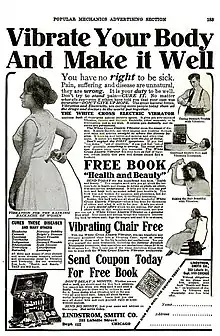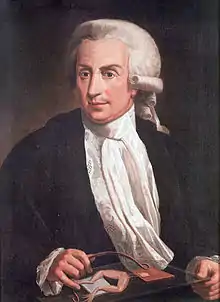Electrotherapy (cosmetic)
Cosmetic electrotherapy is a range of beauty treatments that uses low electric currents passed through the skin to produce several therapeutic effects[2] such as muscle toning in the body[3]: 226 and micro-lifting of the face.[4] It is based on electrotherapy, which has been researched and accepted in the field of rehabilitation,[5] though the "scientific and medical communities have tended to sideline or dismiss the use of electrotherapy for healthy muscles".[6]
.jpg.webp)
The use of electricity in cosmetics goes back to the end of the 19th century,[7][8] almost a hundred years after Luigi Galvani discovered that electricity can make the muscle in a frog's leg twitch[9] (see galvanism). Subsequent research in electrophysiology has been carried out by people such as Robert O. Becker, Dr Björn Nordenström,[10] a former chair of the Nobel Selection Committee for Medicine, and Dr Thomas Wing,[11][12] who invented some of the first micro-current devices.
Treatments

There are four main types of treatment, that differ in the type of current they use (see Comparison table, below), including:
- Galvanic treatment
- Neuromuscular electrical stimulation (NMES) (also known as Faradic treatment)
- Micro-current electrical neuromuscular stimulation (MENS)[14]
- High-frequency treatment
Galvanic treatment
Galvanic treatment in the beauty industry has been described since at least the 1970s[15] and earlier.[13] Sometimes called galvanism, the treatment aims to improve the skin in two ways: (1) cleansing: a process called desincrustation, and (2) nourishing the skin condition, through an electro-chemical process[16] called iontophoresis[17] (also called ionisation).[18] This is achieved by the application of a small, constant, direct current.[19] The treatment works on the principle that charged ions in the skin are either attracted or repelled from the electrodes, resulting in certain chemical effects.[20]
- "Galvanism works by penetrating active substances into the subcutaneous tissues, where they act on the ineffective circulation to bring about an improvement in the vascular and lymphatic interchange in the area. This is completed in a natural and harmless way, and is aided by the actual effect of the galvanic current on the tissues. This improves the function of the cellular membrane, and allows the trapped fluid and fat to be dispersed and eliminated."[21]
Galvanic treatment are often used on the face (facial galvanic treatment) and on the body to treat cellulite (galvanic cellulite treatments).[22]
Faradic treatment
Faradic treatment has also been described in the beauty industry since the 1970s[15] and earlier.[13] The treatment tones the muscles by repeatedly contracting them with the electric current, resulting in their firming and toning, and an increase in muscular metabolism aims to remove waste products more readily.[23] Faradic treatments are generally used on the face and body, and work by contracting muscles with a short pulse of interrupted direct current.[24]
The treatment is also called neuromuscular electrical stimulation (NMES),[25] and some of the manufactures who produce the equipment use their own terms, for example, Slendertone calls it electronic muscle stimulation,[26] or the treatment is called after the name of the manufacturer, such as Ultratone or Slim Master.[3]: 264
Microcurrent treatment
Microcurrent treatments (MENS) have been around since the 1970s in medical applications and are distinguished by their use of micro-ampere currents (i.e. millionths of an amp) which are hardly perceptible, but mimic the body's own bio-electric currents.[3]: 272 The treatment is designed to soften wrinkles and rejuvenate skin, including skin damaged by sunburn, acne, stretch marks, cellulite and scarring.[12]
This increased ATP also energizes the facial muscles, similar to how exercise energizes the muscles of our bodies. Unlike anywhere else on the body, the facial muscles are directly connected to the skin, so the result of energizing the muscle is often an improved, lifted appearance.[27] When used on the face, the treatment has become known as a "non-surgical facelift"[28] and "facial lifting".[3]: 273
Microcurrent treatment works by passing a very small direct current through muscle tissue to stimulate the Golgi tendon organ.[29]
Different microcurrent characteristics, particular the frequency and shape of the changing voltage (waveform), have different effects on the tissue.[3]: 273

|
|
High-frequency treatment
High-frequency treatment uses low-current high-frequency alternating currents, delivered via a glass electrode.[30] Glass electrodes are often filled with either Neon gas which produces pink, orange, or red light or they are filled with Argon or rarefied gas which produces violet light. Because of the color of light that is produced when electricity is passed through the gas, they are inaccurately called ultraviolet or infra-red, however no UV rays or infra-red rays are produced, just visible light. High frequency does current convert some of the oxygen in the air surrounding the electrodes into ozone, the treatment has a germicidal action, and is also drying and warming.[31] Consequently, the treatment is used to aid healing and also to help desquamation (the skin's natural exfoliation) and stimulate sweat and sebaceous glands.[30] Sparking may occur when the electrode is close to the skin and then pulled away repeatedly. Some electrodes may contain a metal coil that produces a mechanical vibration, as well as sparking energy that can be felt indirectly when held in one persons hand while another person uses their hands directly on the skin. Because the effect may be pleasurable, similar devices are used in erotic electrostimulation.
Treatment and current
The characteristics of the treatment current include: (a) whether it is (direct or alternating), (b) current frequency, (c) size of the current (all very small), and (d) the duration and shape of any pulses.
Comparison
| Treatment | Current type | Current range | Frequency | Therapies |
|---|---|---|---|---|
| Galvanic (galvanism) | Direct and constant[3]: 264 | milliAmps (mA)[3]: 215 | None (constant)[3]: 215 | Desincrustation. Iontophoresis[3]: 215 |
| Faradic |
Alternating current used where current flows in both direction | Up to 80 mA[34] | 50–100 Hz[35] | Muscle toning[36] |
| Micro-current Electrical Neuromuscular Stimulation (MENS) Also known as Micro-electrotherapy[37] |
Direct (pulsed)[38] |
300-500μA (microAmps)[38] |
0.1–680 Hz[38][39] | Skin-toning[40] Softens fine lines Facial micro-lifting.[4] |
| High-frequency | Alternating[3]: 237–242 </ref> | Low[3]: 237–242 </ref> | 100,000–250,000 Hz (100 kHz–250 kHz)[3]: 237–242 </ref> |
Conditions the skin. Promotes healing. Antibacterial.[3]: 237–242 </ref> |
Notes
- Desincrustation – A skin cleansing process that softens and emulsifies hardened follicle sebum.[41]
- 1 Amp = 1,000 milliAmps (mA) = 1,000,000 microAmps (μA)
- 1,000 Hz (cycles per second) = 1 kHz
Terminology


The origins of the terms "galvanic" and "Faradism" are described in the medical journal, The Lancet, in 1851. A note reads:
- "We should not omit to state that Dr Duchenne closes a paper (Archives, May 1851)[42] on the subject by these words: 'As it will be useful to create a word which should exactly point out electricity by induction, as well as its application, may it not be allowable to use the name of the philosopher who has discovered this kind of electricity? Thus, in the same way as 'Galvani' has given his name to the electricity by contact, so can we like-wise give to the electricity by induction the name of 'Faraday.' This electricity would then be called 'Faradism,' and its application 'Faradization.' Such names would establish a clear distinction between the electricity by contact and that by induction, whilst they, at the same time, render due honour to a philosopher to whom medical science owes a discovery far more valuable in a therapeutic point of view than that of Galvani.'"[43]
It is noted that:
- "Some terms such as galvanic current and faradic stimulation are unique to physiotherapy. Their definitions given in the literature are far from universal.[44] ... The Clinical Electrophysiology Section of the American Physical Therapy Association established a unified terminology for clinical electrical currents—that is, (a) direct current (b) alternating current (c) pulsed current (Kloth and Cummings, 1991)[45] ... However, this terminology does not appear to have been widely adopted and inconsistencies remain in the literature".[46][47]
See also
- Bio-electric stimulation therapy (BEST)
- Electrotherapy – the use of electricity as a medical treatment
- Electrical muscle stimulation (neuromuscular electrical stimulation (NMES))
- Erotic electrostimulation
- Microcurrent electrical neuromuscular stimulator (MENS)
- Transcutaneous electrical nerve stimulation (TENS) – the use of electric current to stimulate the nerves for therapeutic purposes
References
- David Ames Wells, The science of common things: a familiar explanation of the first principles of physical science. For schools, families, and young students., Publisher Ivison, Phinney, Blakeman, 1859, 323 pages (page 290)
- "Introduction, Facial Electrical Manual, The Carlton Institute. 23 pages. (Page 2)
- Jane Hiscock; Elaine Stoddart; Jeanine Connor (2004). Beauty Therapy, Level 3. Heinemann. ISBN 978-0-435-45640-5.
- Dawn Mernagh-Ward, Jennifer Cartwright, Health and beauty therapy: a practical approach for NVQ level 3, Edition 3, Publisher Nelson Thornes, 2004, ISBN 0-7487-9035-7, ISBN 978-0-7487-9035-7. 420 pages (page 109)
- Robinson AJ, Snyder-Mackler, L. Clinical electrophysiology: electrotherapy and electrophysiologic testing 3rd ed. Baltimore: Lippincott Williams and Wilkins, 2008;151-196, 198-237, 239-274
- Kristin Schaefer Centofanti, "Electrical Stimulation for Health, Beauty, Fitness, Sports Training and Rehabilitation", Advances in Muscle Research, 2008, Volume 4 (Application of Muscle/Nerve Stimulation in Health and Disease), 69-116. (page 69)
- See for example: "Dr Hardaway has remarked the wide usefulness of electrolysis in cosmetic manipulations." in The Medical Times and Register, Volume 16, (Author: Horatio Charles Wood), Publisher The Medical Publishing Company, 1886 (90)
- In the treatment of scars (cicatrix): ".. electro-galvanic currents ought to remove cicatrical tissue of the skin, and thus prove of incalculable value as a cosmetic" in Eclectic medical journal, Volume 45, Ohio State Eclectic Medical Association, Published 1885, (page 99)
- Thomas Thomson, An outline of the sciences of heat and electricity, Publisher Baldwin & Cradock, 1830. "Chapter VII: Of Electricity by Contact" (page 489)
- Mark Woodhouse, Paradigm Wars: Worldviews for a New Age, Publisher Frog Books, 1996, ISBN 1-883319-42-0, ISBN 978-1-883319-42-7, 648 pages (page 192)
- Deborah Powell, MicroCurrent for Horses (and other vital therapies you should know, Publisher Matrix Therapy Products, ISBN 0-9790774-0-0, ISBN 978-0-9790774-0-1 (page 15)
- Dawn Mernagh-Ward, Jennifer Cartwright, Health and beauty therapy: a practical approach for NVQ level 3, Edition 3, Publisher Nelson Thornes, 2004, ISBN 0-7487-9035-7, ISBN 978-0-7487-9035-7, 420 pages (page 108)
- Popular Mechanics, Feb 1909, (page 153)
- Susan Cressy, The beauty therapy fact file, Edition 4, Publisher Heinemann, 2004, ISBN 0-435-45142-1, ISBN 978-0-435-45142-4, 469 pages. (page 160)
- Ann Gallant, Body treatments and dietetics for the beauty therapist, Publisher Nelson Thornes, 1978, ISBN 0-85950-401-8, ISBN 978-0-85950-401-0, Length 392 pages (page 308)
- Karl Augustus Menninger, Martin Mayman, Paul W. Pruyser, "A manual for psychiatric case study", Grune & Stratton, 1952, 355 pages (page 332)
- Susan Cressy, The beauty therapy fact file, Edition 4, Publisher Heinemann, 2004, ISBN 0-435-45142-1, ISBN 978-0-435-45142-4. 469 pages (page 161)
- Ann Gallant, Kathy Gillott, Jackie Howard, Principles and techniques for the beauty specialist, Edition 3, Publisher Nelson Thornes, 1993, ISBN 0-7487-1550-9, ISBN 978-0-7487-1550-3, 328 pages (page 181)
- Dawn Mernagh-Ward, Jennifer Cartwright, Health and beauty therapy: a practical approach for NVQ level 3, Publisher Nelson Thornes, 2004, ISBN 0-7487-9035-7, ISBN 978-0-7487-9035-7, 420 pages (page 138)
- Lorraine Nordmann, Professional Beauty Therapy: The Official Guide to Level 3, Publisher Cengage Learning EMEA, 2007, ISBN 1-84480-696-0, ISBN 978-1-84480-696-6, 650 pages (page 256)
- Ann Gallant, Body treatments and dietetics for the beauty therapist, Publisher Nelson Thornes, 1978, ISBN 0-85950-401-8, ISBN 978-0-85950-401-0, Length 392 pages (page 310)
- "Galvanic Cellulite Treatments", BABTAC, British Association of Beauty Therapy and Cosmetology website, retrieved 5 Nov 2011
- Lorraine Nordmann, Professional Beauty Therapy: The Official Guide to Level 3, Publisher Cengage Learning EMEA, 2007, ISBN 1-84480-696-0, ISBN 978-1-84480-696-6, 650 pages (page 247)
- Dawn Mernagh-Ward, Jennifer Cartwright, Health and beauty therapy: a practical approach for NVQ level 3, Edition 3, Publisher Nelson Thornes, 2004, ISBN 0-7487-9035-7, ISBN 978-0-7487-9035-7, 420 pages (page 132)
- Dawn Mernagh-Ward, Jennifer Cartwright, Health and beauty therapy: a practical approach for NVQ level 3, Edition 3, Publisher Nelson Thornes, 2004, ISBN 0-7487-9035-7, ISBN 978-0-7487-9035-7, 420 pages (page 132)
- "How it Works: Electronic Muscle Stimulation Archived 2011-11-24 at the Wayback Machine" at Slendertone website, retrieved 18 Nov 2011
- "What Is Microcurrent Therapy?". NuFACE. NuFACE.
- Nicholas Perricone, Forever Young: The Science of Nutrigenomics for Glowing, Wrinkle-Free Skin and Radiant Health at Every Age, Publisher Simon and Schuster, 2010, ISBN 1-4391-7734-1, ISBN 978-1-4391-7734-1, 351 pages (page 111)
- Susan Cressy, The beauty therapy fact file, Edition 4, Publisher Heinemann, 2004, ISBN 0-435-45142-1, ISBN 978-0-435-45142-4, 469 pages (page 160)
- Jeanine Connor, Sheila Godfrey, Gil Milsom, BTEC National Beauty Therapy Sciences, Publisher Heinemann, 2004, ISBN 0-435-46243-1, ISBN 978-0-435-46243-7, 381 pages (page 197)
- Susan Cressy, The beauty therapy fact file, Edition 4, Publisher Heinemann, 2004, ISBN 0-435-45142-1, ISBN 978-0-435-45142-4, Length 469 pages (page 153)
- Jeanine Connor, Sheila Godfrey, Gil Milsom, BTEC National Beauty Therapy Sciences, Publisher Heinemann, 2004, ISBN 0-435-46243-1, ISBN 978-0-435-46243-7, 381 pages (page 238)
- Dawn Mernagh-Ward, Jennifer Cartwright, Health and beauty therapy: a practical approach for NVQ level 3 Edition 3, Publisher Nelson Thornes, 2004, ISBN 0-7487-9035-7, ISBN 978-0-7487-9035-7, 420 pages. Chapter 5. "Facial and Body Electrotherapy Treatments" (page 132)
- R.S. Khandpur, Handbook of Biomedical Instrumentation, 2nd Ed., Publisher Tata McGraw-Hill Education, 2003, ISBN 0-07-047355-2, ISBN 978-0-07-047355-3, 944 pages (page 774)
- Basanta Kumar Nanda, Electrotherapy Simplified, Publisher Jaypee Brothers Publishers (2008), ISBN 81-8448-261-2, ISBN 978-81-8448-261-4. 548 pages (page 101)
- "Introduction, Facial Electrical Manual, The Carlton Institute. 23 pages. (Page 21)
- Dawn Mernagh-Ward, Jennifer Cartwright, Health and beauty therapy: a practical approach for NVQ level 3, Edition 3, Publisher Nelson Thornes, 2004, ISBN 0-7487-9035-7, ISBN 978-0-7487-9035-7, 420 pages (page 107)
- Lorraine Nordmann, Professional Beauty Therapy: The Official Guide to Level 3, 4th Edition, Publisher Cengage Learning EMEA, 2010, ISBN 1-4080-1928-0 ISBN 9781408019283, 496 pages. Chapter 8: "Electrical treatments" (page 237)
- F-903 Micro Current Machine User Guide, page 5 (online)
- Lorraine Nordmann, Professional Beauty Therapy: The Official Guide to Level 3, 4th Edition, Publisher Cengage Learning EMEA, 2010, ISBN 1-4080-1928-0 ISBN 9781408019283, 496 pages. Chapter 8: "Electrical treatments" (page 291)
- Catherine M. Frangie, Arlene Alpert, Margrit Attenburg, Diane Carol Bailey, Milady's Standard Cosmetology, Publisher Cengage Learning, 2007, ISBN 1-4180-4935-2, ISBN 978-1-4180-4935-5, 897 pages (page 585)
- Duchenne GBA, Archives Génerales de Médicine, May 1851
- "Medical News, Thursday, August 28th 1851", The Lancet, Volume 2, Publisher Elsevier, 1851 (page 240)
- Sheila Kitchen, Sarah Bazin, "Section F. Low Frequency Currents", Electrotherapy: evidence-based practice, Volume 1, edition 11, Publisher Elsevier Health Sciences, 2002, ISBN 0-443-07216-7, ISBN 978-0-443-07216-1, 347 pages (page 234)
- Reference in quote to: Kloth LC, Cummings JP, Electrotherapeutic Terminology in Physical Therapy, 1991, Alexandria, VA: American Physical Therapy Association.
- Sheila Kitchen, Sarah Bazin, "Section F. Low Frequency Currents", Electrotherapy: evidence-based practice, Volume 1, edition 11, Publisher Elsevier Health Sciences, 2002, ISBN 0-443-07216-7, ISBN 978-0-443-07216-1, 347 pages (page 242)
- See also: Electrotherapeutic Terminology in Physical Therapy, 2000, American Physical Therapy Association, ISBN 978-1-887759-88-5, 60 pages
Bibliography
- Lorraine Nordmann, Professional Beauty Therapy: The Official Guide to Level 3, 4th Edition, Publisher Cengage Learning EMEA, 2010, ISBN 1-4080-1928-0 ISBN 9781408019283, 496 pages. Chapter 8: "Electrical treatments"
- Dawn Mernagh-Ward, Jennifer Cartwright, Health and beauty therapy: a practical approach for NVQ level 3 Edition 3, Publisher Nelson Thornes, 2004, ISBN 0-7487-9035-7, ISBN 978-0-7487-9035-7, 420 pages. Chapter 5. "Facial and Body Electrotherapy Treatments"
- John Low, Ann Reed, Ann Reed (SRP.), Electrotherapy explained: principles and practice, 4th Edition, Publisher Elsevier Health Sciences, 2000, ISBN 978-0-7506-8843-7. 564 pages.
- Basanta Kumar Nanda, Electrotherapy Simplified, Publisher Jaypee Brothers Publishers (2008), ISBN 81-8448-261-2, ISBN 978-81-8448-261-4. 548 pages
External links
- BABTAC, British Association of Beauty Therapy and Cosmetology website: Galvanic Treatments | "Galvanic Cellulite Treatments"
- Electrotherapy Museum website
